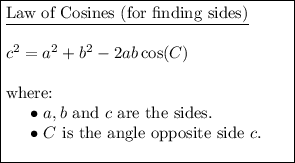Answer:
1) A = 32.6°, C = 111.4°, b = 12.0
2) A = 53.6°, B = 85.7°, C = 40.7°
Explanation:
Question 1
Given values of triangle ABC:
First, find the measure of side b using the Law of Cosines for finding sides.

As the given angle is B, change C for B in the formula and swap b and c:

Substitute the given values and solve for b:




Now we have the measures of all three sides of the triangle, we can use the Law of Cosines for finding angles to find the measures of angles A and C.

To find the measure of angle A, swap a and c in the formula, and change C for A:





To find the measure of angle C, substitute the values of a, b and c into the formula:





Therefore, the remaining side and angles for triangle ABC are:
- b = 12.0
- A = 32.6°
- C = 111.4°

Question 2
To solve for the remaining angles of the triangle ABC given its side lengths, use the Law of Cosines for finding angles.

Given sides of triangle ABC:
Substitute the values of a, b and c into the Law of Cosines formula and solve for angle C:





To find the measure of angle B, swap b and c in the formula, and change C for B:





To find the measure of angle A, swap a and c in the formula, and change C for A:





Therefore, the measures of the angles of triangle ABC with sides a = 21, b = 26 and c = 17 are:
- A = 53.6°
- B = 85.7°
- C = 40.7°